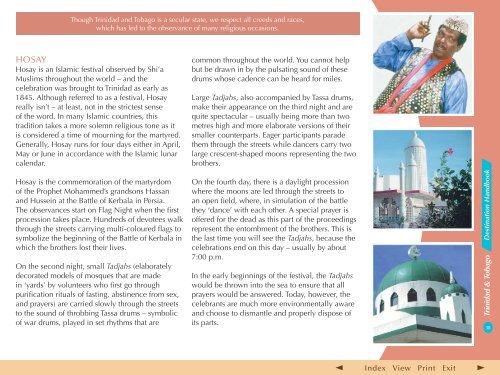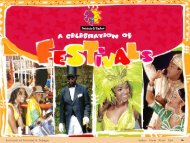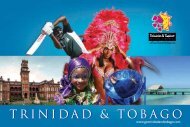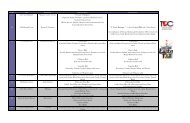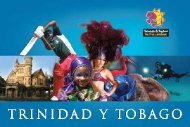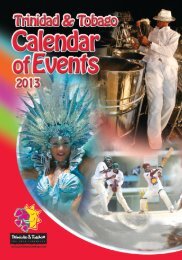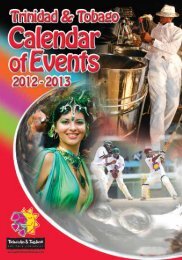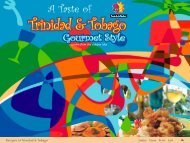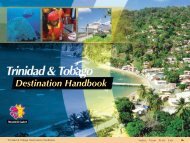Trinidad and Tobago - Destination Handbook
Trinidad and Tobago - Destination Handbook
Trinidad and Tobago - Destination Handbook
You also want an ePaper? Increase the reach of your titles
YUMPU automatically turns print PDFs into web optimized ePapers that Google loves.
\ Index View Print Exit /<br />
Though <strong>Trinidad</strong> <strong>and</strong> <strong>Tobago</strong> is a secular state, we respect all creeds <strong>and</strong> races,<br />
which has led to the observance of many religious occasions.<br />
HOSAY<br />
Hosay is an Islamic festival observed by Shi’a<br />
Muslims throughout the world – <strong>and</strong> the<br />
celebration was brought to <strong>Trinidad</strong> as early as<br />
1845. Although referred to as a festival, Hosay<br />
really isn’t – at least, not in the strictest sense<br />
of the word. In many Islamic countries, this<br />
tradition takes a more solemn religious tone as it<br />
is considered a time of mourning for the martyred.<br />
Generally, Hosay runs for four days either in April,<br />
May or June in accordance with the Islamic lunar<br />
calendar.<br />
Hosay is the commemoration of the martyrdom<br />
of the Prophet Mohammed’s gr<strong>and</strong>sons Hassan<br />
<strong>and</strong> Hussein at the Battle of Kerbala in Persia.<br />
The observances start on Flag Night when the first<br />
procession takes place. Hundreds of devotees walk<br />
through the streets carrying multi-coloured flags to<br />
symbolize the beginning of the Battle of Kerbala in<br />
which the brothers lost their lives.<br />
On the second night, small Tadjahs (elaborately<br />
decorated models of mosques that are made<br />
in ‘yards’ by volunteers who first go through<br />
purification rituals of fasting, abstinence from sex,<br />
<strong>and</strong> prayers) are carried slowly through the streets<br />
to the sound of throbbing Tassa drums – symbolic<br />
of war drums, played in set rhythms that are<br />
common throughout the world. You cannot help<br />
but be drawn in by the pulsating sound of these<br />
drums whose cadence can be heard for miles.<br />
Large Tadjahs, also accompanied by Tassa drums,<br />
make their appearance on the third night <strong>and</strong> are<br />
quite spectacular – usually being more than two<br />
metres high <strong>and</strong> more elaborate versions of their<br />
smaller counterparts. Eager participants parade<br />
them through the streets while dancers carry two<br />
large crescent-shaped moons representing the two<br />
brothers.<br />
On the fourth day, there is a daylight procession<br />
where the moons are led through the streets to<br />
an open field, where, in simulation of the battle<br />
they ‘dance’ with each other. A special prayer is<br />
offered for the dead as this part of the proceedings<br />
represent the entombment of the brothers. This is<br />
the last time you will see the Tadjahs, because the<br />
celebrations end on this day – usually by about<br />
7:00 p.m.<br />
In the early beginnings of the festival, the Tadjahs<br />
would be thrown into the sea to ensure that all<br />
prayers would be answered. Today, however, the<br />
celebrants are much more environmentally aware<br />
<strong>and</strong> choose to dismantle <strong>and</strong> properly dispose of<br />
its parts.<br />
<strong>Trinidad</strong> & <strong>Tobago</strong> <strong>Destination</strong> H<strong>and</strong>book<br />
38


